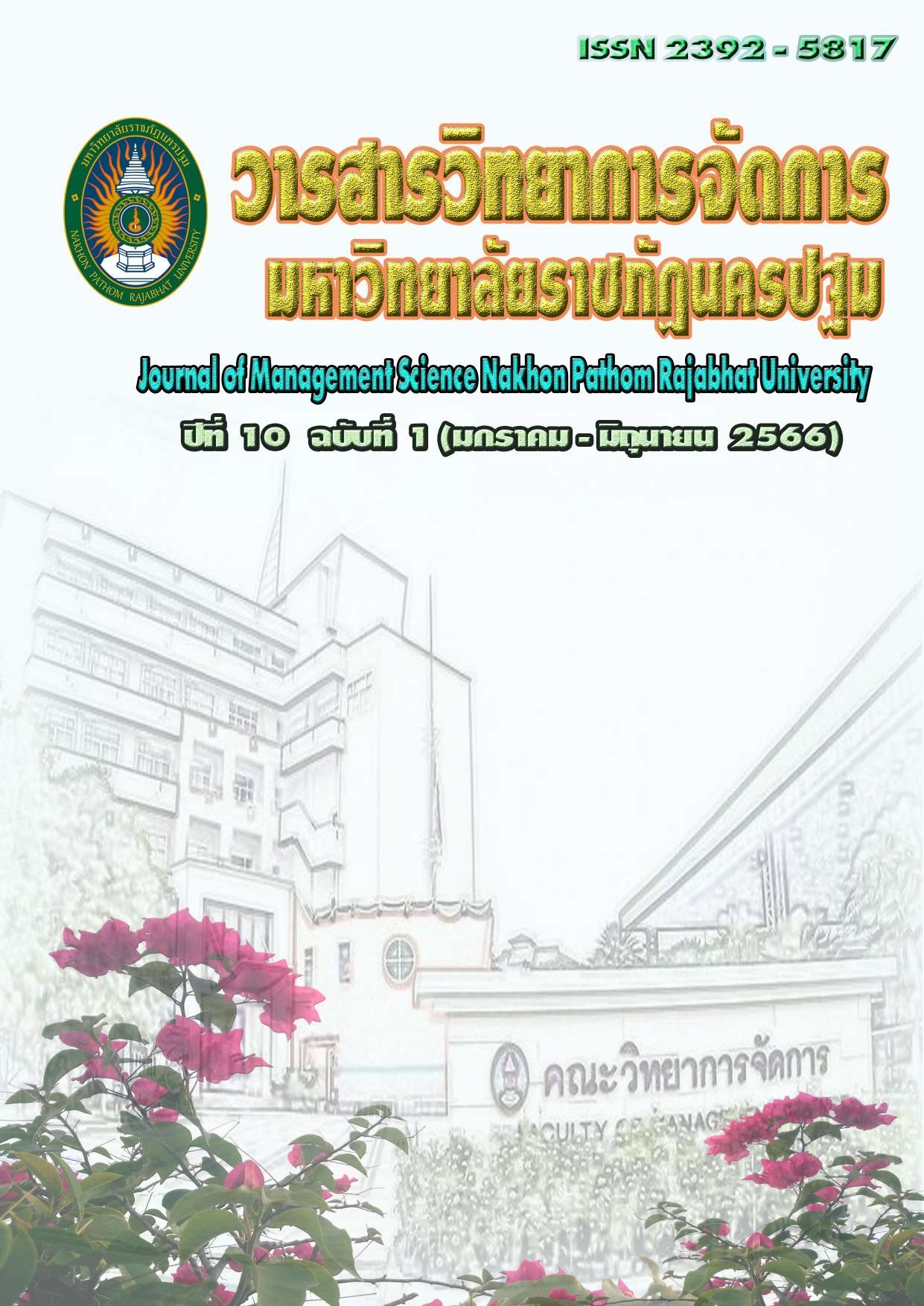Community Based Management for Flood Disaster: A Case Study of Khon Kaen Province and Songkhla Province
Main Article Content
Abstract
This research aims to 1) Study the community-based flood disaster management approach: case studies in Khon Kaen and Songkhla provinces. 2) To study the nature of community participation and level in community-based flood disaster management, a case study in Khon Kaen and Songkhla provinces. 3) To study the problems of community-based flood disaster management, case studies in Khon Kaen and Songkhla provinces. 4) Propose guidelines for community-based disaster management a case study of Khon Kaen and Songkhla provinces.
The research methodology used a qualitative case study approach, with in-depth interviews of 30 key informants 15 per province from regional organizations, local government organizations, and communities involved in disaster management based on community involvement. In addition, document analysis and non - participant observation were used, and data were analyzed using inductive analysis and cross-case analysis.
The study found that 1) community-based disaster management was the foundation of both case studies, which involved dividing the disaster management process into three stages: before, during, and after the event. This was done in the form of a committee and working group appointed by the provincial governor, in compliance with the Disaster Prevention and Mitigation Act of 2007. 2) The nature of community participation involved community surveillance, participation in meetings, expression of opinions, and the establishment of community volunteers. The level of community participation in both cases was only nominal. 3) Regarding the problem of community-based disaster management in both cases, the study found that there was a problem with insufficient budget allocation for disaster management, even though there had been joint planning among various sectors. 4) Recommendations included the need for government agencies to genuinely involve the community in disaster management, and the need to amend laws to promote participation at all levels, in order to reduce risk for the community. It is also important to enhance the knowledge, capabilities of both government agencies, communities in disaster management, to maximize the benefits and efficiency of community capabilities.
From the cross-synthesis of the two community-based flood disaster management case studies, it was found that the disaster management approaches were similar. Things that are different. Songkhla has a plan at the community level for each community, with all sectors participating in planning and providing disaster knowledge to the community. A flood map is prepared. Create a map of vulnerable groups and the preparation of a nanny house or head of the alleys In doing this kind of operation, the province of Khon Kaen does not operate. And different contributions by Khon Kaen Province Participation was at level 4, consultation level, and Songkhla was at level 5, which was just a consolation.
Article history: Received 2 May 2023
Revised 7 June 2023
Accepted 9 June 2023
SIMILARITY INDEX = 3.02%
Article Details

This work is licensed under a Creative Commons Attribution-NonCommercial-NoDerivatives 4.0 International License.
The views and opinions of the article appearing in this journal are those of the author. It is not considered a view and responsibility of the editorial staff.
References
กรมชลประทาน กระทรวงเกษตรและสหกรณ์. (2562). สรุปบทเรียนสถานการณ์อุทกภัยลุ่มน้ำชี-มูล ปี 2562. [ออนไลน์]. ค้นเมื่อ 10 ตุลาคม 2564, จาก http://www.water.rid.go.th/
hyd/Report/Mun_2562.pdf
กรมป้องกันและบรรเทาสาธารณภัย กระทรวงมหาดไทย. (2553). การลดความเสี่ยงจากสาธารณภัย. กรุงเทพมหานคร: บริษัท เวิร์ค พริ้นติ้ง จำกัด.
กรมป้องกันและบรรเทาสาธารณภัย กระทรวงมหาดไทย. (2559). แผนยุทธศาสตร์กรมป้องกันและบรรเทา
สาธารณภัย พ.ศ.2560-2564. [ออนไลน์]. ค้นเมื่อ 10 ตุลาคม 2564, จาก
http://www.policy.disaster.go.th/cmsdetail.Policy-.45/39671/menu_8585/5067.4/แผนยุทธศาสตร์ กรมป้องกันและบรรเทาสาธารณภัย+พ.ศ.2560-2564
คณะทำงานสังเคราะห์บทเรียนการรับมืออภิมหาอุทกภัย. (2554). สังเคราะห์บทเรียนการรับมือมหาอุทกภัย 2554. [ออนไลน์]. ค้นเมื่อ 10 ตุลาคม 2564, จาก https://k4ds.psu.ac.th/k4dm/file/km/hs1975.pdf
โครงการเครือข่ายเมืองในเอเชียเพื่อรับมือกับการเปลี่ยนแปลงสภาพภูมิอากาศ. (2557). เมืองรับมือต่อการเปลี่ยนแปลงสภาพภูมิอากาศ. [ออนไลน์]. ค้นเมื่อ 10 ตุลาคม 2564, จาก
https://www.tei.or.th/thaicityclimate/public/work-7.pdf
สำนักงานคณะกรรมการพัฒนาเศรษฐกิจและสังคมแห่งชาติ. (2554). ผลิตภัณฑ์ภาคและจังหวัดแบบปริมาณลูกโซ่ Gross Regional and Provincial Product. [ออนไลน์]. ค้นเมื่อ 10 ตุลาคม 2564, จาก http://www.nesdb.go.th/Default.aspx?tabid=96
สำนักงานชลประทานที่ 6. (ม.ป.ป.). ระบบน้ำท่วม ลำน้ำพอง-แม่น้ำชี. [ออนไลน์]. ค้นเมื่อ 17 กุมภาพันธ์ 2566, จาก http://www.flood.gistda.or.th
Abarquez, I. and Murshed, Z. (2004). Community-based disaster risk management: field practitioners’ handbook.. Bangkok: Asian Disaster Preparedness Center (ADPC).
Arnstein, S. R. (1969). A Ladder of Citizen Participation. Journal of the American Planning Association, 35(4), pp. 216-224.
Blaikie, P., Cannon, T., Davis, I., and Wisner, B. (2005). At risk: Natural hazards, people’s vulnerability and disasters. New York, NY: Routledge.
Cohen, J. M., and Uphoff, N. T. (1977). Rural development participation: Concept and measures for project design, implementation and evaluation. New York: Cornell University Press.
Coppola, P. D. (2007). Introduction to International Disaster Management. China: Elsevier.
Huxhan, C., and Vangen, S. (2005). Managing to collaborate: The theory and Practice of collaborative advantage. Oxen, England: Routledge.
Izumi, T. and Shaw, R. (2012). Chapter 3 Role of NGOs in Community Based Disaster Risk Reduction. In J. William L. Waugh (Ed.), Community, Environment and Disaster Risk Management, 10, 35-54.
JANI. (2011). Framework on Community Based Disaster Risk Management in Vietnam. Centre for International Studies and Cooperation.
Kapucu, N. (2006). Public-non profit partnerships for collective action in dynamic contexts of emergencies. Public Administration, 84(1), 205-220.
Maskrey, A. (2011). Revisiting Community-Based Disaster Risk Management. Environmental Hazards, 10(1), 42-52.
Mercy Corps and Practical Action. (2010). Establishing Community Based Early Warning System. PRACTITIONER’S HANDBOOK, Mercy Corps Nepal.
O’Brien, G., and O’Keefe, F. (2014). Managing adaptation to climate risk beyond fragmented responses. Oxon: Routledge.
Pineda, M. V. (2015). Redefining Community Based Disaster Risk Management (CBDRM) through Enhanced Early Warning Processes. International Journal of Information and Education Technology, 5(7), 543-548.
Prasad.R. and Cockfield.G. (2014). Perceived community-based flood adaptation strategies under climate change in Nepal. International Journal of Global Warming 6(1), 113 – 124.
Sharma.R. (2021). Community Based Flood Risk Management: Local Knowledge and Actor’s Involvement Approach from Lower Karnali River Basin of Nepal. Journal of Geoscience and Environment Protection, 9, 35-65.
Sjostedt.F. and Sturegard.V. (2015). Implementation of Community Based Disaster Risk Management in the Mekong Delta , Vietnam. Lund University.
Trogrlic, R. S., Wright, G., Adeloye, A., Duncan, M. J. and Mwale, F. (2017). Community based-flood risk management: experiences and challenges in Malawi. International Water Resources Association,1-13.
United Nations Department of Humanitarian Affairs (UNDHA). 2007. DM Glossary, 1992: 28; EEA Environmental Glossary. Geneva, Switzerland: UN/ISDR.


